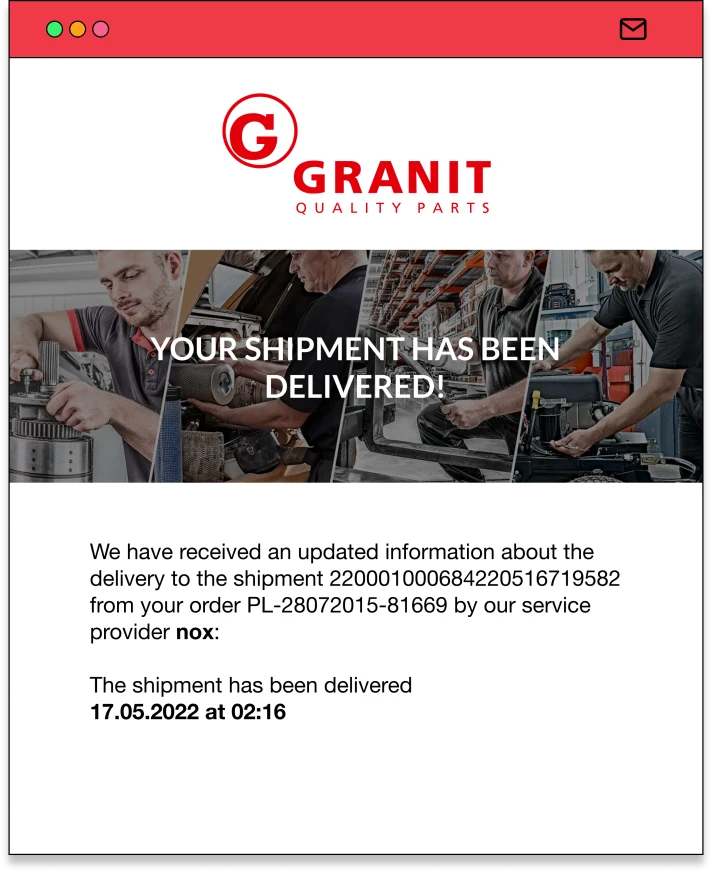Convenience is king in the realm of online retail. It’s not enough to stock great products; you should also ensure that items make it to your customers’ doorsteps in the most efficient way possible.
In other words, timely delivery isn’t just a bonus—it’s a requirement.
That’s why it’s vital to track and improve on-time delivery (OTD) in ecommerce. A top-notch OTD rate paves the way for increased customer satisfaction, repeat purchases, and a healthier business overall.
What’s more, on-time delivery can make or break customer customer relationships. Our research with YouGov found that nearly half (48%) of shoppers say a negative shipping or delivery experience affects their relationship with the retailer. Not only that, but 23% are unwilling to order from a retailer again after a negative delivery experience.
What is on-time delivery?
On-time delivery is a KPI that shows how well and how often a company meets its delivery promises. It’s an important KPI that retailers and logistics companies use to evaluate and improve their shipping efficiency.
Typically expressed as a percentage, ecommerce merchants can use their OTD rate to measure the performance of their shipping and logistics partners (e.g., carriers). The on-time delivery rate can shed light on the productivity of your warehouse teams.
On-time delivery formula
The formula for calculating your on-time delivery rate is:
OTD % = ( Number of orders delivered on time / Total number of orders shipped ) × 100
Let’s break down this equation:
- Total number of orders shipped refers to the total count of orders sent out.
- Number of orders delivered on time is the count of orders that reached the customer within the promised time frame.
For example, if a retailer shipped out 200 orders in a month and 190 of those orders reached their customers on time, then the OTD rate would be:
OTD % = (190 / 200) × 100
= 95%
So, the retailer’s on-time delivery rate is 95%.
What is a good on-time delivery rate?
When it comes to your on-time delivery rate, the faster, the better. That said, a good OTD percentage to aim for is 95% or above, according to Keller Logistics Group.
The question is, are brands living up to their delivery promises?
The results will naturally vary from one company to the next. That being said, parcelLab’s D2C Post-Purchase Experience Study found that on-time delivery performance can vary between D2C and corporate brands. Our research shows that one-fifth of all shipments from D2C and corporate brands arrived later than specified.
| D2C brands | Corporate brands | |
|---|---|---|
| Delivery earlier than specified | 8 | 10 |
| Delivery within the specified time frame | 56 | 54 |
| Delivery 1 day late | 6 | 6 |
| Delivery 2 days late | 2 | 0 |
| Delivery 3 days late | 4 | 4 |
| Delivery 4 days late | 0 | 0 |
| Delivery 5 days late | 2 | 2 |
| Delivery more than 5 days late | 6 | 8 |
| No delivery time | 16 | 16 |
Why is on-time delivery so important?
We’ve said it before, and we’ll say it again: in ecommerce, convenience is king. Consistently providing fast and simple retail experiences—particularly during the post-purchase journey—can do wonders for your brand.
Consider the following:
Improved customer satisfaction
A high on-time delivery rate keeps customers happy. Our research shows that 53% of consumers view the post-purchase stage as the most emotional part of their shopping journey. And since delivery is such a major part of that experience, ensuring that products arrive on time can make or break their perception.

Higher levels of trust
As Digital.gov points out, “Trust can be built upon with good experiences and broken with bad ones”
Consistently keeping your delivery promises leads to higher levels of trust. When products arrive on time, every time, customers know that they can trust and rely on your brand.
This, in turn, fosters customer loyalty and can also lead to positive word-of-mouth recommendations.
More repeat purchases
Speaking of which, OTD is one of the keys to unlocking higher levels of customer loyalty and repeat purchases. Customers are more likely to purchase from you repeatedly when they know that they’ll receive their orders within the promised time frame.
Strong competitive advantage
A consistently high OTD rate sets you apart from competitors who may have an inconsistent delivery track record. As such, keeping your on-time delivery rate high encourages shoppers to choose you over other retailers.
Fewer returns
Delivering on time, especially for time-sensitive items, reduces the likelihood of returns. In some cases, customers may purchase the product from another store if they don’t think the item will arrive on time. For example, if a gift arrives after a birthday, the recipient might just return it after purchasing a replacement product.
Reduced costs
Low on-time delivery rates can lead to more customer inquiries and returns, which eat up your team’s time and resources. As such, keeping delivery issues to a minimum also helps you reduce ecommerce expenses. When products always arrive on time, there are fewer fires to put out, so you’re not shelling out unnecessary costs.
Higher operational efficiency and predictability
When you can trust that products arrive on time, you’re able to have more predictability in your business. A consistent OTD rate makes it easier to forecast and allocate warehouse and customer support resources.
How to improve on-time delivery
Now that we’ve covered the fundamentals of on-time delivery and why it’s important, let’s look at the ways you can improve it. Here are some steps you can take to keep your on-time delivery rate in top shape.
Forecast demand and optimize inventory management
Efficient inventory practices enable you to prevent order delays by ensuring you always have the right stock in the right warehouses at the most optimal time.
As such, you must pay attention to product demand and inventory data so you can stock up accordingly.
Let’s say you’re an apparel retailer and notice a spike in demand for wide-leg pants among your customers on the West Coast. In this instance, it’s helpful to increase stock levels of wide-leg pants in your West Coast warehouses or distribution centers. This ensures quicker fulfillment and delivery for that region. The closer your products are to your customers, the less likelihood of delays and missed delivery time frames.
Streamline your warehouse operations
Enhance your warehouse processes for efficient storage, picking, and packing of products.
One way to improve your warehouse practices is to implement batch picking instead of single-order picking. This means grouping similar orders together and reducing the amount of time and movement needed to gather items. Doing so increases warehouse efficiency so your teams can get products out the door faster.
Opt for less packaging if possible
Avoid using unnecessary packaging. Aside from reducing waste, less packaging also leads to a quicker packing process. In many cases, you also speed up shipping and delivery. For instance, rather than shipping different packages in separate packages, you combine everything in one box (i.e., a single shipment) to minimize handling, reduce shipping costs, and expedite the delivery process for the customer.
Choose the right logistics and delivery partners
Here’s a not-so-fun-fact: on-time delivery is never fully in your control. While you can certainly optimize your internal systems and processes, a big component of OTD performance hinges on your shipping carriers.
That’s why it’s vital to partner with reliable shipping providers who consistently meet your delivery times.
Large carriers such as UPS and FedEx are quite reliable, and they’re generally on top of their delivery processes. That being said, if you’d like to further optimize your on-time delivery performance, you may want to consider regional parcel carriers.
Ideal for merchants that ship to densely populated areas, regional carriers often have faster delivery times—typically one to two days—for their select coverage areas. This makes them a great option if you’re looking to speed up your delivery times without racking up your costs.
Needless to say, you need to track how your vendors are doing and strive to improve carrier performance in the event that issues arise.
Keep your systems tightly integrated
Manual tasks, human error, and disjointed systems create issues and delays. For example, if sales and inventory data aren’t synced with your order management system, your teams could make the mistake of processing orders for out-of-stock items or missing orders entirely.
Meanwhile, if your ecommerce CRM or post-purchase software doesn’t connect with your carrier solution, you could end up sending inaccurate delivery info to your customers.
You can prevent these headaches by ensuring that all your business apps and systems are tightly integrated. Choose solutions with native integrations or open APIs so you can seamlessly sync data across platforms. In doing so, you’ll not only streamline your operations and fulfill orders faster, but you’ll also improve decision-making thanks to real-time insights.
Use data to determine optimal delivery times
The best way to consistently hit your on-time delivery targets is to make accurate delivery promises. When estimating and communicating delivery time frames to your customers, you must ensure you’re giving them the right data. Factor in variables like inventory levels and carrier performance and use that info to provide a delivery window that’s realistic and achievable.
The good news is that you don’t have to do this manually. Solutions like parcelLab can crunch the numbers in the background so you can accurately estimate delivery times.
With parcelLab, you can show customers a delivery promise on product pages to build trust and reduce uncertainty over delivery times. Showing shipping speed (e.g., 3-7 days) is far less effective. Adding an estimated time of arrival is a super simple way to encourage customers to start a cart.
The importance of setting clear delivery expectations

Communication is an important (yet often overlooked) component of on-time delivery. While it’s true that your OTD rate is largely dependent on shipping and delivery, how you communicate with customers matters a great deal as well.
Once you have a handle on an order’s delivery time frame, you need to relay that information to your shoppers to set expectations.
Let’s explore the ways that you can do this.
Setting pre-purchase expectations

Communicate delivery time frames even before a customer places an order. As mentioned earlier, you can do this by analyzing sales, inventory, and carrier data. You can use the insights gathered from these areas to display delivery estimates on your website.
Of course, this task becomes immensely easier when you’re using a platform like parcelLab. Our Convert solution allows you to provide a predictive delivery date that increases conversion rates, reduces consumer uncertainty, and improves customer satisfaction.
parcelLab uses machine-learning algorithms to calculate delivery dates based on your warehouse operations and corresponding delivery methods. We also account for holidays, multiple carriers, weather closures, and staffing shortages to provide the most accurate delivery estimates possible.
Brands that leverage parcelLab Convert are able to convert customers faster and reduce WISMO inquiries by 42%.
Keeping customers in the loop at the post-purchase stage
Forward-thinking brands know that the work doesn’t stop just because you’ve converted a customer. It’s equally important to look after them during their post-purchase stage.
A big part of doing that means implementing parcel monitoring and sending shipping updates. For best results, send branded updates rather than relying on third-party carriers. In addition to giving you better control over the customer experience, this also provides an opportunity to reinforce your brand identity and messaging.
Not to mention, branded emails drive post-purchase engagement, which leads to higher traffic and sales.
We also recommend setting up a branded order tracking page (versus a third-party site). Just like with branded emails, an order tracking site that’s hosted on your domain offers a seamless and consistent brand experience. Plus, it keeps customers within your ecosystem, potentially leading to further engagement or additional purchases.
One example of a company that offers superb post-purchase experiences is GRANIT Parts, a well-known replacement parts specialist for agricultural, gardening, and construction supplies.
Many of GRANIT Parts’ clientele require fast part replacements to continue their operations. So, a high on-time delivery rate is essential. And if delays do occur, GRANIT must communicate them promptly to keep clients informed.
GRANIT leverages parcelLab to stay on top of its post-purchase initiatives. Through parcelLab, the company is able to provide proactive communication in the event of a delay. These updates include specific details about which items in an order are affected so that the customer can plan accordingly.

parcelLab powers GRANIT’s branded emails, along with the company’s order portal. Together, these assets keep GRANIT’s clients in the loop. The company’s initiatives also resulted in 20% fewer inquiry calls and 15% fewer inquiry emails.
“The brand GRANIT PARTS stands for customer orientation and reliability. This is not only reflected in our products, but thanks to parcelLab also in our shipping communication,” says Benjamin Luyten, the company’s head of international partnerships.
Final words
On-time delivery isn’t just a nice bonus—it’s a must-have in the world of ecommerce. If you’re aiming to foster stronger customer loyalty, build unwavering brand trust, and keep those repeat sales rolling in, paying close attention to your OTD performance is an absolute must.
The good news? With the tips provided above, you’re well-equipped to enhance your delivery game and create lasting impressions that keep customers coming back.
FAQ
On-time delivery, or OTD, is a key performance indicator that measures how effectively a company meets its delivery promises. It signifies the ability of a business to consistently deliver products to customers within the promised time frame, ensuring that the items arrive on or before the specified delivery date.
To calculate OTD, use the following formula:
OTD % = ( Number of orders delivered on time / Total number of orders shipped ) × 100
You can enhance your on-time delivery rate by optimizing your internal warehouse processes and integrating your systems. Beyond that, see to it that you’re working with reliable shipping carriers who consistently deliver your product without delays.
Written by



